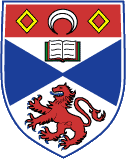Team:St Andrews
From 2010.igem.org
(Prototype team page) |
(Added team and project description - Jim) |
||
| Line 1: | Line 1: | ||
| - | |||
| - | |||
| - | |||
| - | |||
| - | |||
| - | |||
| - | |||
| - | |||
| - | |||
| - | |||
| - | |||
| - | |||
| - | |||
| - | |||
| - | |||
| - | |||
{|align="justify" | {|align="justify" | ||
| - | | | + | |Our multidisciplinary team is the first to come from St Andrews University, consisting of biology students: Dave and Sarah, medical students: Rachael and Fatimeh, physicists: Alasdair and Patrick, computer scientist chemist Jim and biochemist Lukas. We overseen by advisors Olivia, Anne, Wim, Chris and Michael. |
|[[Image:St_Andrews_logo.png|200px|right|frame]] | |[[Image:St_Andrews_logo.png|200px|right|frame]] | ||
|- | |- | ||
| | | | ||
| - | + | The St Andrews iGEM team plan is to do something useful with quorum sensing – the method by which bacteria make decisions in a cell density dependent manner. | |
| - | |[[Image:St_Andrews_team.png|right|frame|Your team picture] | + | |
| + | Cholera is an acute diarrhoeal disease responsible for over 100,000 deaths each year, primarily in developing countries. | ||
| + | Deaths due to cholera are likely to occur due to poor access to treatment by oral or intravenous rehydration therapy. A useful cholera vaccine which is suitable for those most at risk has not yet been found. A probiotic bacterium that colonises the gut could confer long lasting resistance, safely and economically. | ||
| + | |||
| + | The wet work will focus on two challenges. The first being to add new functionality to the cell signalling parts present in the library by building a bi-stable switch using the luxR quorum sensing switch. This will allow the signalling molecule concentration required to activate the system to be different to the concentration required to deactivate it. This will be done by rearranging the lux operon. | ||
| + | The lab team is also looking at the quorum sensing system specific to cholera with the aim of using it against the disease by exploiting the fact that when Vibrio cholera switches off its virulence when it detects that it is present at a high density. | ||
| + | The computational side of the team are focusing on generating ordinary differential equations to model quorum sensing. | ||
| + | and will aim towards modelling more complex problems such as bistability and multiple quorum loops working in tandem | ||
| + | |[[Image:St_Andrews_team.png|right|frame|Your team picture], | ||
|- | |- | ||
| | | | ||
Revision as of 15:38, 14 July 2010
| Our multidisciplinary team is the first to come from St Andrews University, consisting of biology students: Dave and Sarah, medical students: Rachael and Fatimeh, physicists: Alasdair and Patrick, computer scientist chemist Jim and biochemist Lukas. We overseen by advisors Olivia, Anne, Wim, Chris and Michael. | |
|
The St Andrews iGEM team plan is to do something useful with quorum sensing – the method by which bacteria make decisions in a cell density dependent manner. Cholera is an acute diarrhoeal disease responsible for over 100,000 deaths each year, primarily in developing countries. Deaths due to cholera are likely to occur due to poor access to treatment by oral or intravenous rehydration therapy. A useful cholera vaccine which is suitable for those most at risk has not yet been found. A probiotic bacterium that colonises the gut could confer long lasting resistance, safely and economically. The wet work will focus on two challenges. The first being to add new functionality to the cell signalling parts present in the library by building a bi-stable switch using the luxR quorum sensing switch. This will allow the signalling molecule concentration required to activate the system to be different to the concentration required to deactivate it. This will be done by rearranging the lux operon. The lab team is also looking at the quorum sensing system specific to cholera with the aim of using it against the disease by exploiting the fact that when Vibrio cholera switches off its virulence when it detects that it is present at a high density. The computational side of the team are focusing on generating ordinary differential equations to model quorum sensing. and will aim towards modelling more complex problems such as bistability and multiple quorum loops working in tandem | [[Image:St_Andrews_team.png|right|frame|Your team picture], |
| Team Example |
| Home | Team | Official Team Profile | Project | Parts Submitted to the Registry | Modeling | Notebook | Safety |
|---|
 "
"
